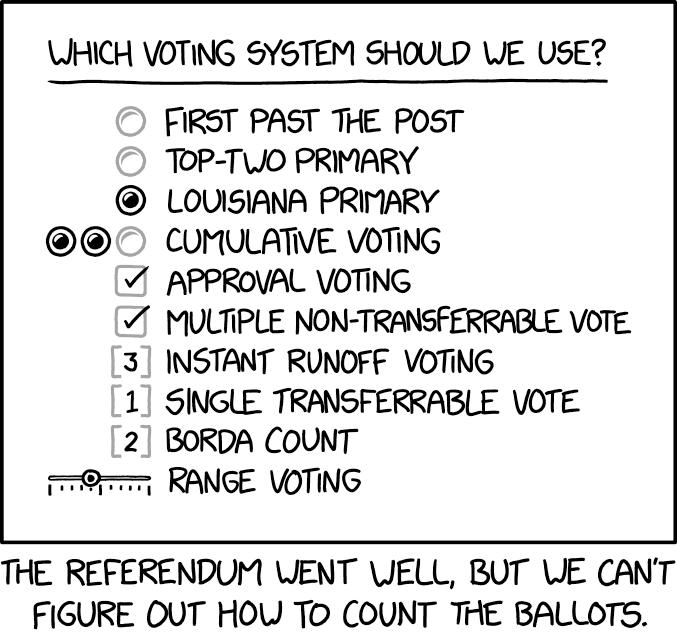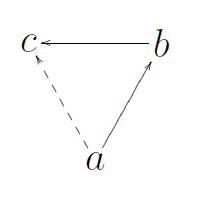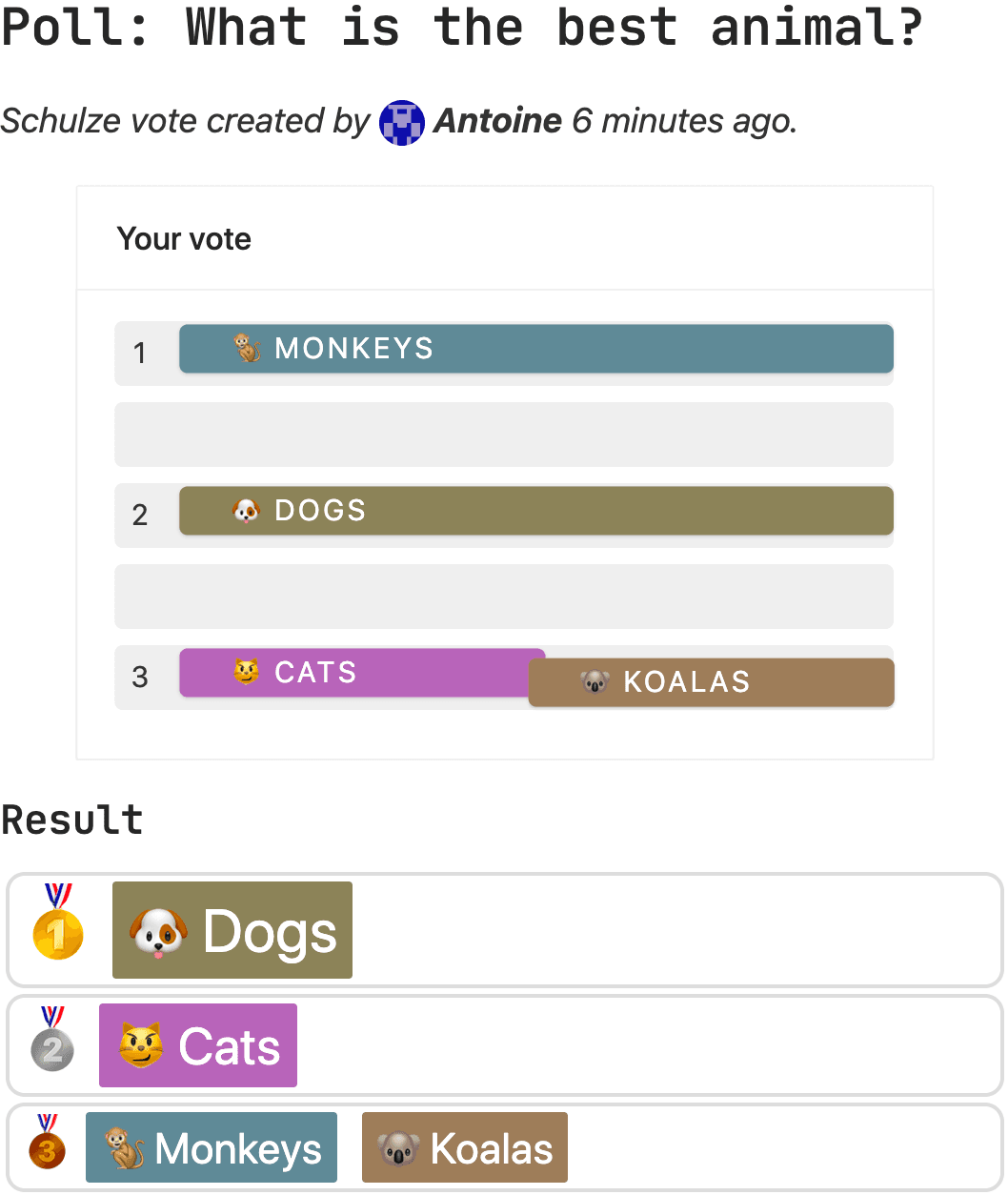🗳 ranked voting systems
🗳️ 😠 📊 😤
How to prevent dishonesty as a winning strategy?
- the Wikipedia article on electoral systems,
- the presentation of Practical Voting Rules and other online documents from Dr Felix Brandt,
- YouTube videos: Politics In The Animal Kingdom from CGP Grey and La démocratie sous l'angle de la théorie des jeux (in French) by Science4All,
ranked 🥇🥈🥉
election systems

- ranked voting: each voter can submit an order of preference between the candidates
- cardinal voting: each voter grades the candidates on a scale. For example rating all candidates between 0 and 5.
Number the boxes in order of your choice.
- 4 Hayden Kelly
- Lesley Poole
- 4 Marley Bennett
- 3 Lesley Mills
- Erin Fraser
- 1 Brett Nielsen
- 4 Noel Curry
- 2 Vic Levy
- Tanner Fleming
- 2 Glen Hoffman
- Voters can rank alternatives in a sequence, possibly with ties. Ballots contain ranked (not rated!) candidates. The ballots accept ties: if voters are indifferent between two candidates, they can put them in the same rank in their ballots.
- The goal of the vote is to compute a hierarchy among the alternatives along with a winner. This means the vote can select options like a restaurant for the evening, a president… Proportional representation, like electing a parliament, is not a subject of this article.
- For the sake of simplicity, ties and tie-breakers are ignored in this article. The examples were chosen not to result in tied situations.
Let's consider an election in the animal world (copying CGP Grey's videos) with a particular voting scenario invented by Michel Balinski, a mathematician, economist and political scientist.This is a virtual election with 100 voters and 5 candidates:🐸 Frog, 🐷 Pig, 🦁 Lion, 🐻 Bear and 🐭 Mouse
The voters can be gathered in 6 groups, each having the same preference order. The preferences of all the voters are represented in this array (which must be read as “33 voters (first column) rank Frog first, then Pig, then Lion, then Bear and finally Mouse is their least favourite; 16 voters (second column) rank Pig first, then Bear, then Lion; etc.”):
| 33 | 16 | 3 | 8 | 18 | 22 |
|---|---|---|---|---|---|
| 🐸 Frog | 🐷 Pig | 🦁 Lion | 🦁 Lion | 🐻 Bear | 🐭 Mouse |
| 🐷 Pig | 🐻 Bear | 🐻 Bear | 🐭 Mouse | 🐭 Mouse | 🦁 Lion |
| 🦁 Lion | 🦁 Lion | 🐷 Pig | 🐷 Pig | 🦁 Lion | 🐷 Pig |
| 🐻 Bear | 🐭 Mouse | 🐸 Frog | 🐻 Bear | 🐷 Pig | 🐻 Bear |
| 🐭 Mouse | 🐸 Frog | 🐭 Mouse | 🐸 Frog | 🐸 Frog | 🐸 Frog |
Probably the most basic voting method. Only the first choice of each voter matters and we simply count the votes. It is used in elections in many countries (the USA, the UK, Canada...).With the voting system first past the post: Frog gets 33 votes, which is better than any other candidates. 🐸 Frog wins.This result can feel unfair because voters' preferences are hardly taken into account. Frog won because it is ranked first by the biggest group (33%), but it is also ranked last by the majority of voters (56%)! That 56% (who ranked Frog last) could potentially come together before the start of the vote and agree on their preferred candidate — which would be Mouse — to prevent Frog from being elected.
With these methods, if no candidate receives 50% of the votes in the first round, a second round of voting is held with only the top two candidates.The Contingent vote lets voters cast their preference order at once and the winner can be computed without needing another vote.In two-round run-off elections, voters are only asked about their preferred candidate. They have to vote again in the second round. 47 countries (Finland, France, Russia, Turkey...) use this system for their presidential elections.A candidate ranked last by more than 50% of the voters cannot be elected by these methods.With the voting system two-round run-off: Frog and Mouse compete in the second round and 🐭 Mouse wins with 64% of the votes.But Mouse is still the second most disliked candidate: if we remove the most disliked candidate (Frog), we are left with 52% of the voters ranking Mouse last! Those voters can understandably be unsatisfied and ask for a different system to be used.
Counting only the first choices of the voters, the candidate with the fewest votes is eliminated. The election repeats until there is a winner. It is used for example to elect members of the Australian House of Representatives, the president of India and the president of Ireland.Lion is eliminated first, then Pig, then Mouse, then Frog. The final winner of the instant run-off vote is 🐻 Bear.Knowing the outcome of that vote, some groups could have changed their ballots to prevent Bear's election. For example, the 33%-group could decide to rank Pig first, and provoke the election of Pig instead of Bear!Coombs' rule is a similar voting method where the candidate ranked last by most voters gets eliminated each round. This rule would elect Pig.
For each voter, every candidate is given points corresponding to their rank in the voter's preferences. In our case: the first position gets 5 points, the second position gets 4 points… It is currently used to elect members of the Parliament of Nauru and two ethnic minority members of the National Assembly of Slovenia.With Borda's rule: 🐷 Pig wins with 347 points, and Lion is second with 344 points.If the voters knew that the race would be so close between Pig and Lion, they probably would have tried to influence the election by ranking them as the first or the last in their ballots. Since 51% of the voters prefer Lion to Pig, they can change the outcome of the election. This kind of phenomenon often leads political systems to be bipartisan.
Finally, someone found the perfect voting system for this election! Copeland's method considers all duels between the candidates and counts the number of victories, similarly to a tournament.
🐸 Frog: 0 🐷 Pig: 3 🦁 Lion: 4 🐻 Bear: 2 🐭 Mouse: 1
To visualize the duels, it is helpful to simplify the representation of the input by using a graph instead of an array of preferences.The preference of the first group of voters (33%: Frog → Pig → Lion → Bear → Mouse) can be represented like this:Adding the preferences of all the voters, we get the full graph:Did I say simplify? 😬
We can still combine opposed edges, which makes it way more readable:
After seeing Copeland's method, you may think “Just pick the candidate that wins all duels!”. It would be great if this was always possible, but unfortunately, there are situations where no candidate wins all duels and a cycle appears.

| Number of voters | Preference order |
|---|---|
| 6 | 🌯 Burrito > 🍕 Pizza > 🍔 Burger > 🍪 Cookie |
| 4 | 🍕 Pizza > 🍪 Cookie > 🍔 Burger > 🌯 Burrito |
| 4 | 🍪 Cookie > 🍔 Burger > 🍕 Pizza > 🌯 Burrito |
| 1 | 🌯 Burrito > 🍔 Burger > 🍕 Pizza > 🍪 Cookie |
| 6 | 4 | 4 | 1 | |
|---|---|---|---|---|
| 🥇 | 🌯 Burrito | 🍕 Pizza | 🍪 Cookie | 🌯 Burrito |
| 🥈 | 🍔 Burger | 🍪 Cookie | 🍔 Burger | 🍔 Burger |
| 🥉 | 🍕 Pizza | 🍔 Burger | 🍕 Pizza | 🍕 Pizza |
| 💩 | 🍪 Cookie | 🌯 Burrito | 🌯 Burrito | 🍪 Cookie |
| vs. | 🌯 Burrito | 🍔 Burger | 🍕 Pizza | 🍪 Cookie |
|---|---|---|---|---|
| 🌯 Burrito | -1 | -1 | -1 | |
| 🍔 Burger | 1 | 7 | -1 | |
| 🍕 Pizza | 1 | -7 | 7 | |
| 🍪 Cookie | 1 | 1 | -7 |
The Copeland voting system, which we saw above, validates the Condorcet criteria. Some more complex voting systems can validate the Condorcet criterion and also score better on other criteria (see below).The previous election example was too simple: there was a Condorcet winner (Lion) which deserved to win, and it would be selected as a winner by all those Condorcet-methods. With a new fictional election in the animal kingdom, we can compare our new voting systems.
| 1 | 1 | 1 | 2 | 3 | 3 | 4 | 4 | 4 | 6 | 7 | 10 | 12 | |
|---|---|---|---|---|---|---|---|---|---|---|---|---|---|
| 1 | 🐷 Pig🐻 Bear🐭 Mouse | 🐸 Frog | 🦁 Lion | 🦁 Lion | 🐻 Bear🐭 Mouse | 🐻 Bear | 🐸 Frog🦁 Lion🐻 Bear | 🐷 Pig | 🐻 Bear🐭 Mouse | 🐷 Pig | 🦁 Lion | 🐭 Mouse | 🐸 Frog |
| 2 | 🐸 Frog | 🦁 Lion | 🐷 Pig | 🐷 Pig🐻 Bear🐭 Mouse | 🐸 Frog🦁 Lion | 🐸 Frog🦁 Lion | 🐷 Pig | 🐭 Mouse | 🐸 Frog | 🦁 Lion | 🐻 Bear | 🐸 Frog🦁 Lion🐻 Bear | 🐷 Pig |
| 3 | 🦁 Lion | 🐷 Pig🐻 Bear🐭 Mouse | 🐻 Bear🐭 Mouse | 🐸 Frog | 🐷 Pig | 🐷 Pig | 🐭 Mouse | 🐸 Frog🦁 Lion🐻 Bear | 🐷 Pig | 🐻 Bear🐭 Mouse | 🐷 Pig | 🐷 Pig | 🐭 Mouse |
| 4 | 🐸 Frog | 🐭 Mouse | 🦁 Lion | 🐸 Frog | 🐭 Mouse | 🦁 Lion🐻 Bear | |||||||
| 5 | 🐸 Frog |
Select the candidate for which the biggest pairwise defeat is smaller than the biggest pairwise defeat of all other candidates.
| vs. | 🐸 Frog | 🐷 Pig | 🦁 Lion | 🐻 Bear | 🐭 Mouse |
|---|---|---|---|---|---|
| 🐸 Frog | 8 | 1 | -7 | -9 | |
| 🐷 Pig | -8 | -2 | -4 | 10 | |
| 🦁 Lion | -1 | 2 | 3 | -5 | |
| 🐻 Bear | 7 | 4 | -3 | -6 | |
| 🐭 Mouse | 9 | -10 | 5 | 6 |
To compute the winner with Ranked Pairs methods, iterate through the edges of the graphs by descending strength and accept them in a graph as long as they do not create cycles. The resulting graph is acyclic and its root is the election winner.The generated acyclic graph has the order “🐷 → 🦁 → 🐸 → 🐭 → 🐻”.🐷 Pig wins the ranked pairs vote.
For each pair of candidates, find the path from one to the other with the strongest weakest link (the path using the edges which are as strong as possible). The candidate which has stronger paths outwards than paths inwards is the winner. In the following example, click on the array cells to highlight the paths of the duels.Bear has paths to all opponents that are stronger than the paths from the opponents to Bear. Therefore, 🐻 Bear is the winner with the Schulze method."Schulze method users included Debian, Gentoo, Topcoder, Wikimedia, KDE, the Pirate Party of Sweden, and the Pirate Party of Germany" (Wikipedia).
Find an order that contradicts as few preferences as possible. This method can take very long to compute if there are many candidates because there are n! possibilities, with n being the number of candidates. For 5 candidates, there are already 120 possibilities to check (of course there are certainly better ways to greatly reduce the search space).The order “🐭 → 🦁 → 🐻 → 🐸 → 🐷” is the one that contradicts edges the least (by the sum of weights): 2 edges with a total value of 11 points have a direction opposite to that order. The top candidate of this order,🐭 Mouse, wins the election with Kemeny's rule.
Randomization: the solution against strategic voting
All the methods listed above share the same flaw: they are all vulnerable to strategic voting. Meaning that there can be situations in which a voter could lie about his or her preferences and end up with a preferred outcome, that is unfair.Vulnerability to strategic voting is probably the worst flaw of voting systems. This is a problem of all real-world methods. By introducing randomness to the process, some resistance to tactical voting can be built.Also known as random dictator, this voting system simply consists of picking a ballot at random, which determines the winner. Despite its simplicity, this method has the advantage of being resistant to tactical voting.Using the preference profiles from above the generated lottery is as follows:🐸: 24.71% 🐷: 17.82% 🦁: 19.54% 🐻: 14.08% 🐭: 23.85%
While it is great to be strategy-resistant: the random ballot voting system has many flaws. For example, an unfortunate roll of dice could give the win to a heavily disliked candidate. And, more importantly, this method fails the Condorcet criterion.
The maximal lotteries method consists in computing the Nash equilibrium corresponding to the matrix of duels. Then assigning probabilities to candidates proportionally to their score in the Nash equilibrium.With the duel matrix A, we must find a vector v such asv A ≥ 0 (meaning all values of the product are positive).In our example the matrix A is:
Probability Distribution:
🐷: 30.63%
🦁: 26.13%
🐻: 14.41%
🐭: 18.92%

To compare the voting systems that were presented, there is a list of criteria that can be used.
Condorcet: If one candidate wins all duels against others, then that candidate must win the election. W
Majority: If one candidate is ranked first by more than 50% of voters, then that candidate must win. W
Monotonicity: By redoing an election with everything unchanged but the preferences of 1 voter, which now rank 1 candidate higher in the list, then the election result should not place this candidate lower than before. In other words, an individual should not be able to hurt an option by ranking it higher. W
Pareto efficiency: If every voter prefers alternative X over alternative Y, then the system prefers X over Y. W
Independence of irrelevant alternatives (IIA): Assuming voter preferences regarding other candidates are unchanged, the winner never changes if a non-winning candidate is added or removed. W
Local Independence of irrelevant alternatives (LIIA): Assuming voter preferences regarding other candidates are unchanged, removing the candidate at the first place or the last place should not change the order of the remaining candidates. W
Non-dictatorship: The result of the voting cannot be determined by the preference of one voter without taking the other votes into account. W
Strategy proof: Lying about preferences never leads to a preferred outcome W
A mathematician, Dr Kenneth Arrow, showed that no rank-order deterministic voting system could fulfil those 3 criteria: non-dictatorship, Pareto efficiency, and independence of irrelevant alternatives. The theorem is Arrow's impossibility theorem. This means that we have to make some compromises by giving up on some criteria.
Another theorem is easier to understand. It goes like this (paraphrased from Wikipedia):
In deterministic ordinal electoral systems (aka ranked voting) that choose a single winner, for every voting rule, one of the following three things must hold:
- The rule is dictatorial, i.e. there exists a distinguished voter who can choose the winner; or
- The rule limits the possible outcomes to two alternatives only; or
- The rule is susceptible to tactical voting: in certain conditions, a voter's sincere ballot may not best defend their opinion.
Most data come from the comparison of electoral systems on Wikipedia. In some cases (marked with a ”?“) I don't know if the method validates the criterion.
Condorcet | Majority | Monotonicity | Pareto efficiency | IIA | LIIA | Non-dictatorship | Strategy proof | |
|---|---|---|---|---|---|---|---|---|
| Maximal lotteries | ||||||||
| Randomized Condorcet | ||||||||
| Ranked pairs | ||||||||
| Schulze method | ||||||||
| Kemeny–Young method | ||||||||
| Minimax Condorcet method | ||||||||
| Copeland's method | ||||||||
| Approval voting | ||||||||
| Borda's count | ||||||||
| Instant-runoff | ||||||||
| Coombs rule | ||||||||
| Two-round system | ||||||||
| Plurality | ||||||||
| Random ballot |
You may want the check some related projects from other people:
- Electoral system on Wikipedia.
- To Build a Better Ballot: an interactive guide to alternative voting systems.
- Politics in the animal kingdom: series of videos from CGP Grey (the great Youtuber) which presents voting methods.
- Le scrutin de Condorcet randomisé: a Youtube video (in French) from the channel Science4All. The description contains many links to related work.
- Handbook of Computational Social Choice: a 500 pager that can teach you everything about this topic.
- Election Science - The center for election science: A non-partisan, non-profit dedicated to empowering people with voting methods that strengthen democracy. Their website is a wonderful source of content, for example, this interview of Dr Kenneth Arrow or this assessment of 6 single-winner voting methods.
- fairvote.org: An initiative and application for Ranked Choice Voting (using Instant-run-off, or Single Transferable Vote in case of a multi-winner election). A voting application is also available on rankit.vote.
- Modern Ballots: on-line and off-line voting platform using Schulze's method.
- Condorcet Vote is a very similar application. It is written in PHP and the algorithms are available in a library
- voting.ml: a voting tool originated from a project at the Technical University of Munich (TUM).
- votation.ovh: an application (in French) to create votes using maximal lotteries.
- votevote.page: an educational toy showing election results for many voting systems.